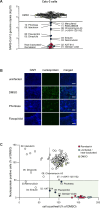Repurposing screen identifies novel candidates for broad-spectrum coronavirus antivirals and druggable host targets
- PMID: 38319076
- PMCID: PMC10916382
- DOI: 10.1128/aac.01210-23
Repurposing screen identifies novel candidates for broad-spectrum coronavirus antivirals and druggable host targets
Abstract
Libraries composed of licensed drugs represent a vast repertoire of molecules modulating physiological processes in humans, providing unique opportunities for the discovery of host-targeting antivirals. We screened the Repurposing, Focused Rescue, and Accelerated Medchem (ReFRAME) repurposing library with approximately 12,000 molecules for broad-spectrum coronavirus antivirals and discovered 134 compounds inhibiting an alphacoronavirus and mapping to 58 molecular target categories. Dominant targets included the 5-hydroxytryptamine receptor, the dopamine receptor, and cyclin-dependent kinases. Gene knock-out of the drugs' host targets including cathepsin B and L (CTSB/L; VBY-825), the aryl hydrocarbon receptor (AHR; Phortress), the farnesyl-diphosphate farnesyltransferase 1 (FDFT1; P-3622), and the kelch-like ECH-associated protein 1 (KEAP1; Omaveloxolone), significantly modulated HCoV-229E infection, providing evidence that these compounds inhibited the virus through acting on their respective host targets. Counter-screening of all 134 primary compound candidates with SARS-CoV-2 and validation in primary cells identified Phortress, an AHR activating ligand, P-3622-targeting FDFT1, and Omaveloxolone, which activates the NFE2-like bZIP transcription factor 2 (NFE2L2) by liberating it from its endogenous inhibitor KEAP1, as antiviral candidates for both an Alpha- and a Betacoronavirus. This study provides an overview of HCoV-229E repurposing candidates and reveals novel potentially druggable viral host dependency factors hijacked by diverse coronaviruses.
Keywords: CRISPR/Cas9; HCoV-229E; SARS-CoV-2; antivirals; coronavirus; host-targeting antiviral therapy; repurposing.
Conflict of interest statement
The authors declare no conflict of interest.
Figures







References
-
- Gorbalenya AE, Baker SC, Baric RS, de Groot RJ, Drosten C, Gulyaeva AA, Haagmans BL, Lauber C, Leontovich AM, Neuman BW, Penzar D, Perlman S, Poon LLM, Samborskiy DV, Sidorov IA, Sola I, Ziebuhr J, Coronaviridae Study Group of the International Committee on Taxonomy of Viruses . 2020. The species severe acute respiratory syndrome-related coronavirus: classifying 2019-nCoV and naming it SARS-CoV-2. Nat Microbiol 5:536–544. doi:10.1038/s41564-020-0695-z - DOI - PMC - PubMed
-
- Lawrenz J, Xie Q, Zech F, Weil T, Seidel A, Krnavek D, van der Hoek L, Münch J, Müller JA, Kirchhoff F. 2022. Severe acute respiratory syndrome coronavirus 2 vaccination boosts neutralizing activity against seasonal human coronaviruses. Clin Infect Dis 75:e653–e661. doi:10.1093/cid/ciac057 - DOI - PMC - PubMed
Publication types
MeSH terms
Substances
Grants and funding
- 14-76103-184 CORONA-13/20/Niedersächsisches Ministerium für Wissenschaft und Kultur (MWK)
- RESIST 390874280/Deutsche Forschungsgemeinschaft (DFG)
- Deutsches Zentrum für Infektionsforschung (DZIF)
- HAI-IDR/Helmholtz-Alberta Initiative (HAI)
- CRC900 158989968/Deutsche Forschungsgemeinschaft (DFG)
- 417852234/Deutsche Forschungsgemeinschaft (DFG)
- Knut och Alice Wallenbergs Stiftelse (Knut and Alice Wallenberg Foundation)
- 01KI20143C/Bundesministerium für Bildung und Forschung (BMBF)
- Niedersachsen Vorab/Niedersächsisches Ministerium für Wissenschaft und Kultur (MWK)
- 76251-99/Niedersächsisches Ministerium für Wissenschaft und Kultur (MWK)
LinkOut - more resources
Full Text Sources
Research Materials
Miscellaneous

